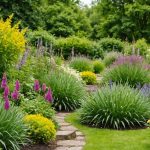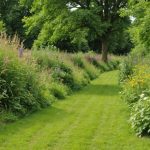Introduction to Wildlife Gardening
Wildlife gardening is an engaging and rewarding way to enhance biodiversity, especially in the UK ecosystems. By creating a space that welcomes wildlife, gardeners play a crucial role in supporting local animal populations. This approach involves using native plants, which are tailor-made for the local climate and soil, making them a sustainable choice for any garden.
Adding native flora to your garden attracts a variety of indigenous wildlife such as bees, butterflies, and birds. This helps reverse the decline of these species by providing essential resources like food, shelter, and breeding grounds. Native plants offer high levels of nourishment and familiarity, ensuring that local wildlife can thrive.
Have you seen this : Enhancing biodiversity: creative hedgerow strategies for sustainable farming in the uk
One critical aspect of wildlife gardening is its transformative impact on biodiversity. Gardens become thriving microhabitats that bolster local ecosystems by maintaining a balanced environment. This is not just beneficial for wildlife but also enriches the gardening experience for us, making the garden a lively and pleasant space.
Using native plants in gardens has the added advantage of minimal upkeep, as they are naturally adapted to local conditions. This means less watering, fewer fertilizers, and an overall reduction in gardening effort, offering an eco-friendly solution and a beautiful, vibrant landscape.
Also to read : Preserving the past: a deep dive into the uk”s initiatives and strategies for protecting ancient trees
Selecting Native Plants
Understanding native plant selection is key to fostering a vibrant ecosystem. Native plants are adapted to the local climate and soil conditions, making them crucial for supporting UK flora and plant diversity. They offer ideal habitats and food sources for wildlife, enhancing biodiversity in your garden.
To choose the right native plants, consider each species’ unique characteristics and their benefits to wildlife. For instance, plants like the Common Hawthorn provide berries for birds and shelter for small creatures. Native plants like Bluebells attract pollinators with their bright colours and nectar.
Identifying suitable native plants involves assessing your garden’s specific conditions, such as soil type, sunlight, and moisture levels. Sandy soils support Heather, while clay soils are suitable for Meadowsweet. Shady areas might thrive with Dog’s Mercury, flourishing even in low-light environments.
Recommended native plants for various UK wildlife include:
- Birds: Elderberry and Rowan, both offering berries.
- Pollinators: Wild Marjoram and Lavender, excellent for bees.
- Small mammals: Plants like Hazel and Bramble provide dense cover.
In essence, incorporating diverse native plants in garden planning not only aids wildlife but also supports a sustainable and resilient environment.
Designing Wildlife-Friendly Spaces
Crafting a garden design that welcomes local wildlife is both rewarding and sustainable. To foster biodiversity, key elements should be prioritised. Incorporating diverse wildlife-friendly features can transform a simple yard into a thriving ecosystem.
To start, consider habitat creation by planting native flora. Native plants support local insects and animals, offering food and habitat. For example, berry-producing shrubs are an excellent choice for attracting birds and small mammals. Additionally, a variety of plants can cater to an assortment of wildlife, each contributing to the garden’s dynamic ecosystem.
Incorporating microhabitats ensures diverse species find a home in various niches within your garden. Rock piles or logs can shelter reptiles and amphibians, while dense shrubs provide cover for rabbits and hedgehogs. Each element plays a crucial role in maintaining ecological balance.
Moreover, water sources are vital for sustaining wildlife. Installing a small pond or birdbath can draw a plethora of animals, including birds, amphibians, and insects. Ensure the water is clean and accessible for different species.
Lastly, providing shelter like birdhouses, bat boxes, or insect hotels can invite beneficial creatures to make a permanent residence. These features encourage a healthier, more balanced ecosystem and enrich your garden experience.
Practical Steps for Garden Maintenance
Maintaining a garden that thrives on sustainable practices requires strategic care. Embracing ecological balance is crucial to nurturing a wildlife-friendly garden. Begin by prioritising organic pest control methods. Techniques such as companion planting and introducing beneficial insects can minimise chemical use, enhancing the ecosystem’s health.
Sustainable gardening practices are integral to promoting biodiversity. Incorporate native plants as they are adapted to local conditions and provide food for local wildlife. By doing so, you can create habitats that encourage thriving communities of birds, insects, and other animals.
Regular maintenance ensures that the garden remains a sanctuary for wildlife. Focus on soil health by using natural compost and mulch. These not only enrich the soil but also retain moisture, resulting in healthier plant growth without the need for synthetic fertilisers.
Moreover, mindful water use is another key element. Implementing rainwater collection systems and utilising drip irrigation can reduce water wastage and support ecological balance. This is particularly important for wildlife gardens, where water can attract and sustain various species.
Being attentive to these practices not only keeps your garden flourishing but also contributes to a more sustainable and wildlife-friendly environment, ensuring your garden remains a vibrant oasis.
Benefits of Wildlife Gardening
Wildlife gardening offers numerous environmental benefits by creating habitats that support various species, promoting biodiversity. Such gardens provide essential resources such as food, water, and shelter for local wildlife, aiding in their survival. They help maintain ecological balance by attracting pollinators like bees and butterflies, crucial for plant reproduction, and create natural pest control by inviting beneficial insects and birds that prey on garden pests.
The ecological importance of wildlife gardening extends further by enhancing local ecosystems. By enriching soil health through natural composting and reducing the need for pesticides and herbicides, these gardens contribute positively to the environment. This, in turn, supports healthier plant growth and cleaner water sources, fostering a more resilient ecological network.
Wildlife gardening also has a significant community impact. It fosters community spirit by bringing people together who share a passion for gardening and the environment. Community wildlife gardens offer shared green spaces where residents can collaborate, learn, and enjoy nature together. Such collaborative efforts can improve mental well-being and encourage eco-friendly habits.
Moreover, wildlife gardening provides educational opportunities for families and neighbours. It serves as a living classroom, teaching children and adults alike about the importance of conservation, native species, and sustainable practices. Observing real-time ecosystems can inspire future conservationists and broaden community awareness about the environment.
Real-Life Examples and Case Studies
Wildlife gardening in the UK is replete with inspiring success stories. These local initiatives provide valuable insights and lessons for those eager to enhance biodiversity in their own backyards.
Consider the renowned River of Flowers project, a nationwide initiative creating urban corridors of wildflowers. It exemplifies how collaboration between communities and experts leads to flourishing habitats that support pollinators such as bees and butterflies. This project highlights the impact of localized efforts, proving that even small spaces can make a significant difference.
Another compelling example is the Thames Valley Wildlife Gardening Scheme. This initiative encourages residents to transform their gardens into wildlife havens. By planting native species and creating varied habitats, participants have reported increased sightings of birds, hedgehogs, and other wildlife. The scheme’s success underscores the importance of community engagement in fostering environments where nature can thrive.
From these case studies, several lessons emerge:
- Local collaboration and expert guidance are instrumental.
- Even small changes can create meaningful results in urban ecosystems.
- Diverse plant species foster resilient habitats that support greater biodiversity.
These wildlife gardening success stories demonstrate practical approaches and the positive impacts of local initiatives, offering a beacon for those wanting to undertake similar projects.











